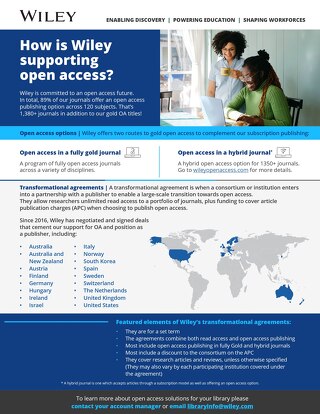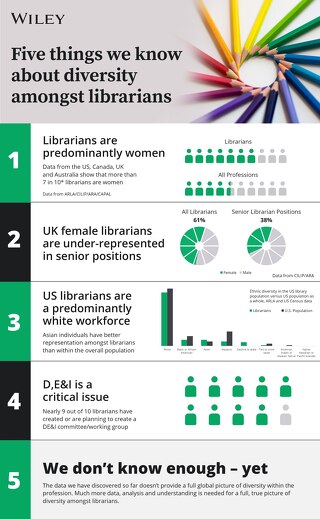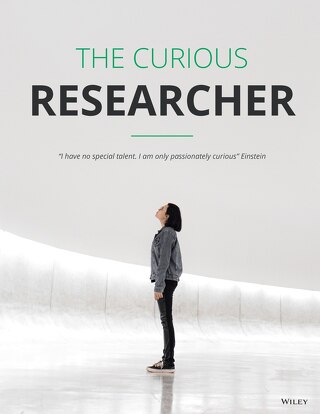6-trends-driving-technology-adoption-in-libraries
February 23, 2018
As Benjamin Franklin, founder of one of the earliest lending libraries in America, once said, “When you’re finished changing, you’re finished.” Fortunately for all of us, academic and research libraries (ARLs) are apparently not finished just yet. At least, they are not finished according to the NMC Horizon Report: 2017 Library Edition. In this report education and technology experts identify six trends they predict will influence technology-related decision-making by academic and research libraries over the next five years, as they evolve into the libraries of the future.
The Report is produced by the NMC Horizon Project, an effort founded in 2002 to study technological developments expected to significantly impact education-related institutions (i.e., schools, libraries and museums). This is the third library-related report the organization has issued and, as with the Project’s earlier library-related reports, the trends identified in the 2017 edition are projections arising from an examination of current and ongoing organizational changes within academic and research libraries worldwide. After an exhaustive review of technology-impacting trends, the Horizon Project team selected what they determined to be the two most impactful trends over each of three projected time frames: short-, mid-, and long-term.
Short-Term Trends are those considered to be currently driving technology adoption in academic and research libraries but which are expected to become either commonplace or to fade in importance over the next one to two years. For this time frame, the two trends considered the most impactful by the Project’s experts include Research Data Management and Valuing the User Experience.
1. Libraries taking on Research Data Management
While libraries have traditionally played two primary functions—providing patrons with access to data and providing support for data research efforts—rapidly expanding capabilities for generating and storing data have resulted in ARLs adopting a third role: Research Data Management (RDM). As applied here, RDM includes both of the traditional roles ARLs have played while adding an increased emphasis on implementing appropriate and needed storage and retrieval systems. With more numerous data formats being utilized (including digital, graphics and A/V formats), new policies, procedures and processes are being developed to address issues from data generation and curation to safeguarding privacy.
2. Valuing the User Experience
Just as Google and Amazon and other companies have developed user-data-driven processes to provide increasingly personalized services to their customers, so ARLs have recognized the importance of continually improving their patrons’ interactions with their libraries. In response, ARLs are developing practices, processes and technologies designed to improve patron interactions, whether these involve library computer systems, signage, use of space, or any other aspect of the patrons’ touchpoints with library resources and staff. The results from these efforts might range from the implementation of search engines that provide more personally tailored search results to the addition of digital displays throughout facilities that direct patrons to available seating.
Mid-Term Trends are those expected to become increasingly vital in driving technology adoption over the next several years and to have their greatest impact on decision-making over the next 3-5 years. The two most impactful trends discussed in the Report for this time frame include Patrons as Creators and Rethinking Library Spaces.
3. Patrons as Creators
In recent years pedagogical practices in higher education have begun to incorporate hands-on and other experiential learning to a much greater degree. This development reflects greater societal trends that we popularly recognize in the form of crowd-funding endeavors or you-tube videos, and so on. Simply put, people are increasingly learning by making and doing rather then by simply consuming content. In response to this trend, ARLs are evolving into providers of creation-enabling technologies in addition to their traditional roles. For example, libraries are increasingly introducing “makerspaces” within their facilities which include technologies such as 3D printers and video and audio tools that support creative activities by patrons.
4. Rethinking Library Spaces
This trend is closely associated with the Patrons as Creators trend. With the advent of the internet, students and other researchers are much less dependent on ARLs as primary providers of source materials. Rather, most researchers begin their data searches online and libraries are increasingly seen primarily as resources where scholars can find conditions conducive to productivity and/or where they can meet with others to work on creative projects collaboratively. In response, ARLs are looking closely at how library spaces can best be utilized to service these evolving patron needs. For example, some libraries have begun identifying specific spaces as collaborative work studios and have begun equipping such spaces with technologies supportive of collaborative creative endeavors. The result might include classroom space with flexible display screens set up to facilitate teleconferencing, or studios equipped with media production technologies, and so on.
Long-Term Trends are trends seen as currently impacting technology adoption decisions and which are predicted to continue to do so for the next five years and more. The Horizon Project’s two most impactful trends over this timeframe include Cross-Institution Collaboration and the Evolving Nature of the Scholarly Record.
5. Cross-Institution Collaboration
With the increasing digitalization of data (including text, visual and audio) comes the opportunity for academic and research libraries to share content virtually instantaneously. This, combined with tightening budgets and other social trends towards resource-sharing efficiencies, has resulted in ever stronger collaborative efforts among ARLs. Libraries have begun joining together to share ever larger digital collections, allowing them to provide patrons with access to greater research resources. By sharing patron usage data, they are increasingly enabled to develop technology strategies that better respond to patron needs. Working together on a worldwide basis, for example, they can do a better job of identifying and supporting broad academic and pedagogical trends such as the ascension of “hands-on” learning in academia.
6. Evolving Nature of the Scholarly Record
The advent of the internet has moved scholarship away from a print-based and hard copy print-distribution model to an electronic publishing and distribution process. This has sped up and changed the peer-review process in significant ways. Whereas in the past the slower print-based review process provided substantial safeguards against the distribution of faulty research efforts, for example, the new digital publishing reality will mandate that libraries evolve in terms of how they accept, validate, curate and disseminate research materials going forward. One emerging ARL initiative to help address this trend includes developing advocacy groups that promote open access and open peer review approaches to scholarly submissions.
In addition to these six trends affecting ARL technology adoption, the Report also discusses technology challenges libraries face as well as opportunities further technological developments may bring. We will discuss these challenges and opportunities in upcoming posts, so stay tuned! Coming up next month: Six Challenges Impeding Academic and Research Library Technology Adoption.
Permission is granted under a Creative Commons Attribution 4.0 International license to replicate, copy, distribute, transmit, or adapt this report freely provided that attribution is provided as illustrated in the citation below. To view a copy of this license, visit us here.
Citation
Adams Becker, S., Cummins, M., Davis, A., Freeman, A., Giesinger Hall, C., Ananthanarayanan, V., Langley, K., and Wolfson, N. (2017). NMC Horizon Report: 2017 Library Edition. Austin, Texas:The New Media Consortium.










